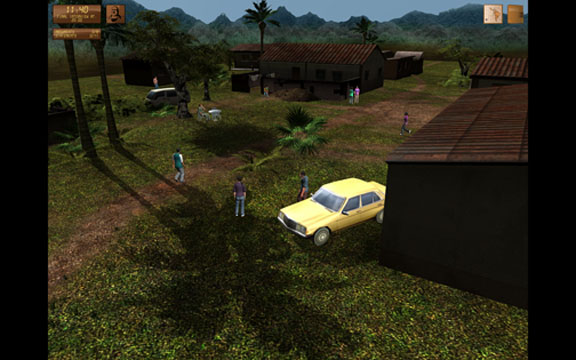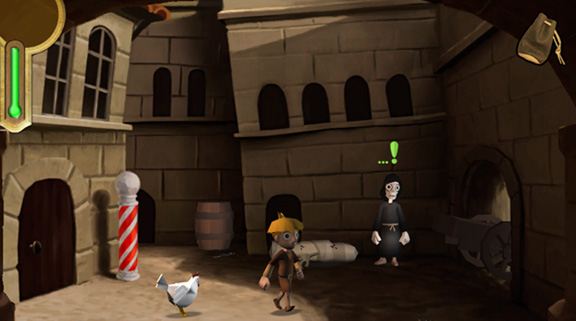- Introduction to the Issue
- Whose Literacy Is It Anyway? Examining a First-Year Approach to Gaming Across Curricula
- Computer Games Across the Curriculum: A Critical Review of an Emerging Techno-Pedagogy
- What Games Have to Teach Us About Teaching and Learning: Game Design as a Model for Course and Curricular Development
- Four Ways to Teach with Video Games
- Life in Morrowind: Identity, Video Games, and First-Year Composition
- Stings and Scalpels: Emotional Rhetorics Meet Videogame Aesthetics
- The Avatar that therefore I Am (Following)
- Machinima-to-Learn: From Salvation to Intervention
- Procedural Rhetorics / Rhetoric's Procedures: Rhetorical Peaks and What It Means to Win the Game
- Gone Gitmo: An Interview with Co-Creators Nonny de la Peña and Peggy Weil
- Serious Games Interactive Interview
- Contributors' Notes
Serious Games Interactive Interview
Over a couple of weeks in April 2010, Currents editorial staffer Dustin D. Stewart conducted an interview by e-mail with Dr. Mikkel Lucas Overby of Serious Games Interactive (SGI). Based in Copenhagen, SGI is an award-winning, research-based developer of games, simulations, and virtual worlds that works with corporations, state agencies, NGOs, and other organizations. As Commercial Director, Dr. Overby serves as a member of SGI's management team. He completed a PhD on the use and performance of strategic alliances at Copenhagen Business School and Stanford University.
Below are highlights from Overby's responses, organized by the major themes on which we based our questions.

Below are highlights from Overby's responses, organized by the major themes on which we based our questions.
Serious Games
There is a vivid debate on whether the term "serious games" is meaningful at all. We [at SGI] believe so. Our take on this is that we consider serious games to be games with a purpose that beyond entertainment. There is no doubt that players can learn from playing most computer games. What distinguishes "serious" from "unserious" games is the extent to which this learning has value outside the game world. It is the serious game designer's task to ensure that the game contains valuable information that can be applied outside the game world. Most often the explicit learning objectives are defined before the game is designed.
Academia
Serious games can be deployed in many contexts and domains (e.g., military, health, corporate, educational). Focusing on the education domain, I think that a lot of teachers are finding it challenging to reap the full benefits from using games in their teaching. Computer games represent a new educational medium, and if you are not familiar with the medium it does require some extra hours of preparation to maximize the output. At the same time, most students are finding it surprising to discover that until a few years ago relatively few people (including academics) understood the value of using games for learning. For many young people today, this is an obvious fact.
Teaching
These are good questions. We have the challenge of having to design games with specific learning objectives that all players must meet and which typically cannot take more than 45-60 minutes (the length of a typical lecture) to play. This is a challenge because we want to give players the opportunity of making different decisions leading to different outcomes. As educational games become more widely used, production budgets will increase, which in turn will allow developers to do more branching within a game, while meeting learning-objective and time requirements.
Narrative
Games do tell stories, but the extent to which they do can differ depending on the genre and the game design. We have taken the adventure-game genre as our point of departure and games of this type usually have a strong narrative. In comparison, the strategy-game genre is more focused on systems. The range of stories that games can tell is the same as in other media. They can tell everything from fairytales to documentary stories. However, games can tell the stories differently, because they can put the player in the story and allow his or her decisions to affect the progress of the story. For TV, radio, and books, the only influential decision the user can make is to shut it off or put it away.
Structure
We are constantly adjusting the balance between freedom and structure in our games. In our Global Conflicts game series (www.globalconflicts.eu), we tilted towards structure. We wanted to give the players an authentic experience and made the product closer to a simulation than to an actual game. In our new game series Playing History (www.playinghistory.eu), we leaned the other way. Our main focus here was to allow the players to learn through explorational discovery, and the adventure-game elements are therefore very strong. We also added a number of mini-games to allow for variation and replayability.

Figure 1: Image captured from Global Conflicts: Latin America

Figure 2: Image captured from Global Conflicts: Sweatshops

Figure 3: Image captured from Playing History: The Plague
Rules
We do not really work with "game-breaking" in our designs, but there is no doubt that sometimes our games are used for discussions that go beyond what we had imagined when designing them.
Culture
In general we are more open and sensitive to things we experience ourselves than things we hear or read about. Computer games aim to let the player live the life of the avatar and experience the virtual world. Hence, in theory computer games can be a strong medium for forming [individual] attitudes, opinions, and behavior, as well as culture.
Funding
Funding is a major concern for serious game developers. In the educational market, we have yet to see a blockbuster title, and until we can show some cases with a good return, the investment in educational game production will be low (or must come from not-for-profit entities). Low production budgets, however, do not equal low-quality games in all dimensions. While animations and effects are expensive and most often improve with budgets, gameplay and mechanics are the result of creative processes that can be supported by constraints, as, for instance, is the case with the Danish Dogme films. Generally speaking, I think that the most ambitious educational games today were intended to be for-profit but ended up involuntarily being not-for-profit. (The case is different with serious games in general, as several companies have made money on games for military and health purposes.) However, I believe this will change in the coming years as the market for educational games grows.
Feeling
Games that deeply affect our feelings in ways different from simply being entertained or excited are not, I think, common. In this respect, the medium is still primitive compared to the wide range of emotions that movies play on. We are involved in a European research project (www.playmancer.com) among the tasks of which is to develop games for mentally disabled people. This is highly interesting as we are looking into technologies that can measure emotions and emotional change.
Like movies, games can be used to promote certain messages and evoke certain feelings in their audiences. Hamas, to take an eye-catching example, has developed a game that explains the wrongdoings of Israelis and challenges players to bomb as many of them as possible. The reward structure in the game is not much different from those in other games, but when you replace imaginary virtual worlds with real-world simulations, the player may have difficulties separating the game world from the real world. As this example suggests, this fuzzy boundary can be used for good causes (e.g., the whole games-for-change movement) along with bad ones.


